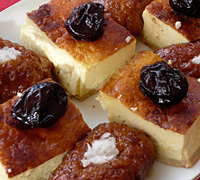Food
Cape Malay cuisine is a fusion food born in Africa. Its alimentary origins can be found in the cooking pots of 17th and 18th century exiled dissidents and slaves brought to the Cape from the Dutch East Indies. While there are recognizable Asian elements, Cape Malay cooking has undergone a considerable degree of adaptation to suit local conditions and ingredient availability.
Food plays an important role in the community life of the Cape Malay. The Javanese have always believed that it is not enough to simply provide your guests with good food; you must do more than that. You must entertain them with good conversation and make them feel welcome and appreciated.
The meals are not served in their respected courses; all the courses are laid out simultaneously on the table. Everyone decides for himself/herself what he or she chooses to eat first. The lady of the household seldom sits at the table. She sees to everyone's comfort.
Geel rys (yellow rice) made with saffron, cinnamon and raisins provides the perfect accompaniment to the gentle aromatic flavours of bredie lamb casseroles. Mouth-watering crayfish curries are mopped up with flaky textured roti breads. And no Cape Malay meal is complete without condiments which range from palate-cooling sambals to fiery blatjang chutneys, pickles and atjars. Sweet-toothed travellers should look out for oval coconut rolled koesister fritters (which are the antecedent of Afrikaaner platted koeksisters). .
Food plays an important role in the community life of the Cape Malay. The Javanese have always believed that it is not enough to simply provide your guests with good food; you must do more than that. You must entertain them with good conversation and make them feel welcome and appreciated.
The meals are not served in their respected courses; all the courses are laid out simultaneously on the table. Everyone decides for himself/herself what he or she chooses to eat first. The lady of the household seldom sits at the table. She sees to everyone's comfort.
Geel rys (yellow rice) made with saffron, cinnamon and raisins provides the perfect accompaniment to the gentle aromatic flavours of bredie lamb casseroles. Mouth-watering crayfish curries are mopped up with flaky textured roti breads. And no Cape Malay meal is complete without condiments which range from palate-cooling sambals to fiery blatjang chutneys, pickles and atjars. Sweet-toothed travellers should look out for oval coconut rolled koesister fritters (which are the antecedent of Afrikaaner platted koeksisters). .









